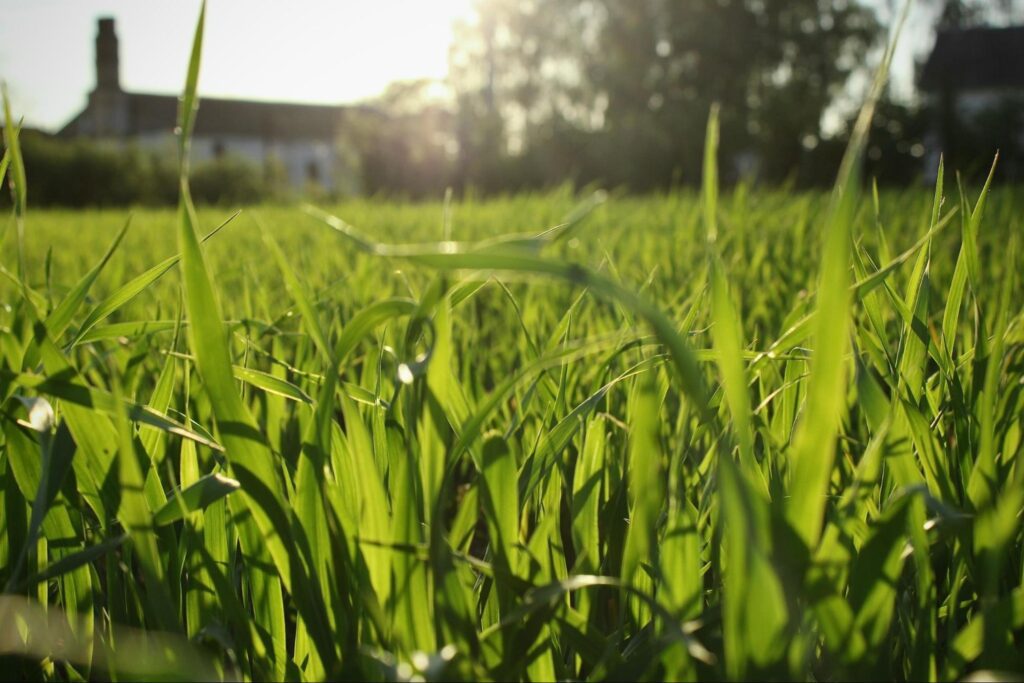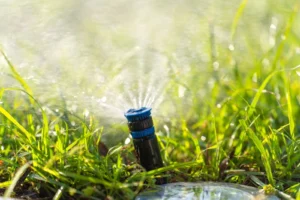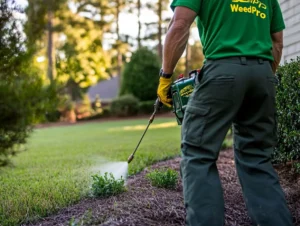Weather plays a pivotal role in the effectiveness of weed control methods. Understanding how variations in temperature, precipitation, humidity, and wind impact weed growth and management can significantly enhance your lawn care strategies. A solid grasp of weed biology—how weeds grow, develop, and respond to environmental stresses—is crucial, as these physical and physiological characteristics directly influence how weather affects weed control effectiveness. As Weed Pro focuses on delivering precision weed control tailored to Atlanta’s unique climate, it’s essential to consider these factors to keep your lawn lush and thriving. Let’s jump into how different weather conditions influence weed control effectiveness and what you can do about it.
Understanding the Relationship Between Weather and Weeds
Weather conditions drastically influence weed germination, growth, and the efficacy of herbicides. Weed science plays a crucial role in understanding how weather patterns affect weed germination and growth, helping to inform more effective management strategies. The interplay of these factors can shorten the windows for effective management or introduce new weed species, often tied to climate fluctuations. Understanding this relationship is fundamental in advancing your lawn care approach, especially when identifying the target weed and considering how weather impacts its management.
Temperature and Its Impact on Weed Growth
Temperature is a critical factor affecting every phase of weed life cycles. Air temperature is a key environmental factor influencing weed growth and herbicide performance. Higher temperatures can boost germination rates, with optimal growth typically seen up to about 95°F (35°C). The ideal temperature range for herbicide application is important to maximize effectiveness and minimize risks. Beyond this, germination can actually decline. Also, the impact of temperature on herbicides varies:
- Some herbicides perform optimally in warmer conditions, enhancing their effectiveness. Warmer temperatures can accelerate plant growth and influence herbicide absorption.
- Conversely, others work better in cooler climates, making timing crucial for application. Lower temperatures and cooler temperatures can slow herbicide activity and absorption.
- Extreme heat can lead to faster degradation of herbicides, potentially increasing weed resistance. Hot weather can also increase herbicide volatility and crop injury risk.
The timing of herbicide application should also consider the growth stage and weed size for optimal results. Most post emergent herbicides and post emergence herbicides are particularly sensitive to temperature conditions for optimal efficacy. Stressed crops due to temperature extremes may require adjustments in herbicide application timing or formulation.
Precipitation: The Role of Water in Weed Control
Rainfall is vital for effective weed management, particularly following herbicide applications. A timely rain event is crucial for activating certain herbicides. For pre-emergence herbicides to work, a rainfall amount of 2 to 4 inches within 15 days is typically needed. Multiple rain events can influence the activation and movement of herbicides in the soil. Conversely, lack of rainfall can diminish the effectiveness of these treatments. Wet weather can also pose challenges for herbicide application and weed control. Pay attention to:
- Insufficient Rainfall: Reduces herbicide uptake and effectiveness.
- Excessive Rain: Can wash away herbicide applications, leading to subpar results. Precipitation events immediately after application can reduce absorption and effectiveness. Heavy rain can cause herbicide leaching and reduce residual activity.
Pre-emergence herbicides require moist soil for proper activation. The soil profile, including texture and organic matter, affects herbicide movement and efficacy. Higher organic matter can enhance herbicide retention and microbial activity. Chemical degradation and chemical reactions in the soil are influenced by moisture and temperature, affecting herbicide persistence. Root uptake of herbicides is enhanced by timely rainfall but can be reduced by early or heavy rain. Residual herbicides provide ongoing weed control and depend on rainfall for activation. Preemergence herbicides require proper timing and soil moisture for effectiveness. Cover crops can be part of a rotation strategy influenced by herbicide restrictions and rainfall patterns. Rainfall immediately after application can reduce absorption by washing herbicides off plant surfaces.
Humidity and Its Effects on Herbicide Efficacy
Humidity not only affects weed growth but also herbicide absorption:
- High humidity promotes better uptake of foliar herbicides as the leaf cuticle softens. Humidity also influences the characteristics of the leaf surface, which can directly impact how effectively herbicides are absorbed.
- When humidity is low, cuticles thicken, which can hinder absorption, causing ineffective treatments.
- Drought conditions can stress weeds, impacting their susceptibility to herbicides as their physiological states change. Environmental conditions, including humidity, can also influence the appearance and progression of herbicide symptoms on weeds.
Wind Conditions and Application Challenges
Wind presents unique challenges in herbicide application. While you want a breeze to avoid inhaling chemicals, strong winds can cause:
- Drift: This occurs when herbicides are carried away from the intended application site, which reduces the effectiveness and poses risks to adjacent plants.
- Application Precision: Low wind days are preferable: but, completely still conditions may lead to the volatilization of certain herbicides. Hence, timing applications to avoid windy conditions can significantly improve results.
Adapting herbicide treatments to wind conditions is essential for effective weed control and minimizing environmental impact.
Best Practices for Weed Control in Varying Weather Conditions
To navigate the complexities introduced by weather variations, consider these best practices:
- Accurate Identification: Know your weed species and choose herbicides effectively designed for your local climate conditions.
- Optimal Timing: Apply treatments during favorable temperatures, usually within the 60°F to 75°F range for maximum efficacy.
- Surfactants and Techniques: Use the right surfactants and adjust your spray nozzles/volumes based on humidity and wind conditions.
- Flexible Herbicide Program: Develop a flexible herbicide program that integrates both preemergence and postemergence applications, and can be adjusted based on changing weather conditions and weed emergence.
Most herbicides require careful consideration of weather patterns, such as rainfall and temperature, to maximize their effectiveness and minimize issues like leaching or degradation.
Seasonal Considerations for Effective Weed Management
Timing is crucial as spring typically sees a surge in weed germination. Early intervention is essential for managing emerging weeds before they become established and harder to control. Monitor your local weather patterns to determine the optimal times for both pre-emergent and post-emergent applications. Timely application is especially important as weeds emerge before rainfall activates residual herbicides, making postemergence control critical. Keep in mind:
- Seasonal rainfall influences the effectiveness of both herbicides and mechanical control methods like tilling.
Always consult the herbicide label for specific seasonal application guidelines, crop rotation restrictions, and safety instructions.
Adjusting Strategies Based on Climate Trends
Climate shifts are leading to increasingly unpredictable weather patterns, which in turn necessitates adjustments in your weed management strategies:
- Integrated Approaches: Combine chemical methods with cultural, mechanical, and biological controls to enhance resilience against shifting weather conditions. It’s important to adapt weed management strategies to various weather impacts, such as drought, heat, and precipitation variability, to ensure consistent results.
- Monitoring: Keep an eye on emerging weed species and changes in competitive dynamics driven by climate changes. Ensuring herbicides are properly translocated within weeds is essential for effective control under changing climate conditions.
- Herbicide Combinations: Use mixtures of herbicides to increase reliability in controlling weeds as weather patterns become more erratic.
Understanding how weather affects weed control effectiveness is essential for anyone looking to maintain a vibrant lawn. By adapting your strategies based on temperature, precipitation, humidity, and wind conditions, you can enhance your weed control outcomes significantly. As Weed Pro continues to provide tailored lawn care solutions in Atlanta, embracing these weather-aware practices will ensure you keep your yard thriving, no matter the climate challenges.
Frequently Asked Questions
How does temperature impact weed control effectiveness?
Temperature influences every phase of weed growth. Optimal growth typically occurs up to 95°F (35°C), but extreme heat can cause herbicides to degrade quickly, increasing weed resistance.
What role does precipitation play in weed management?
Rainfall is crucial for herbicide effectiveness. Pre-emergent herbicides require 2 to 4 inches of rain within 15 days to function properly, while too much rain can wash away applications.
Why is humidity important in herbicide absorption?
High humidity enhances the uptake of foliar herbicides by softening the leaf cuticle, while low humidity can thicken the cuticle, leading to ineffective absorption and treatment.
What are the best practices for applying herbicides in windy conditions?
Aim to apply herbicides on low-wind days to prevent drift and ensure precision. However, completely calm conditions may cause certain herbicides to volatilize, impacting efficacy.
Can weather variations lead to new weed species emergence?
Yes, climate fluctuations can introduce new weed species. Monitoring local weather patterns helps in adjusting control strategies to manage these changes effectively.
How can I improve weed control during seasonal weather changes?
Adapting your strategies based on seasonal weather patterns is vital. Use integrated approaches that combine chemical and mechanical controls to enhance effectiveness throughout different conditions.







